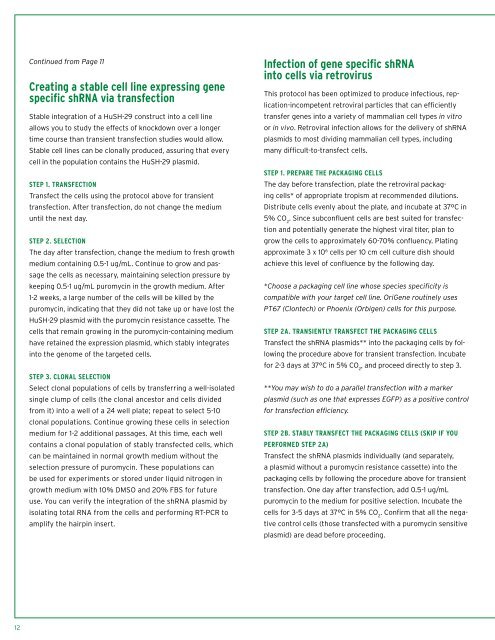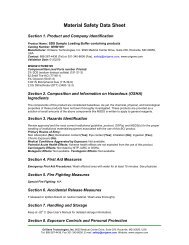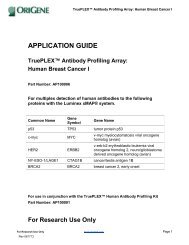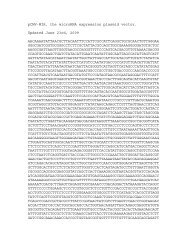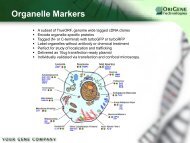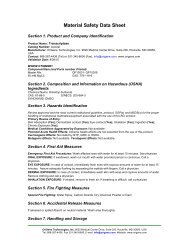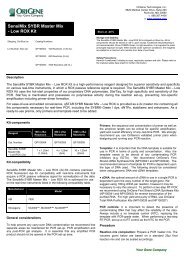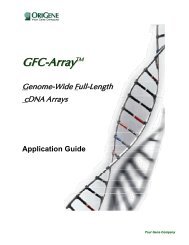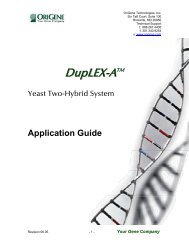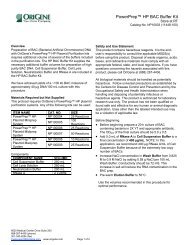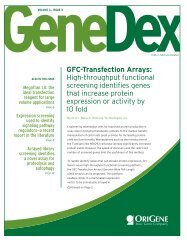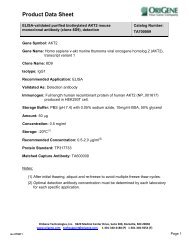shRNA and shRNA vectors - OriGene
shRNA and shRNA vectors - OriGene
shRNA and shRNA vectors - OriGene
You also want an ePaper? Increase the reach of your titles
YUMPU automatically turns print PDFs into web optimized ePapers that Google loves.
Continued from Page 11<br />
Creating a stable cell line expressing gene<br />
specific <strong>shRNA</strong> via transfection<br />
Stable integration of a HuSH-29 construct into a cell line<br />
allows you to study the effects of knockdown over a longer<br />
time course than transient transfection studies would allow.<br />
Stable cell lines can be clonally produced, assuring that every<br />
cell in the population contains the HuSH-29 plasmid.<br />
Step 1. Transfection<br />
Transfect the cells using the protocol above for transient<br />
transfection. After transfection, do not change the medium<br />
until the next day.<br />
Step 2. Selection<br />
The day after transfection, change the medium to fresh growth<br />
medium containing 0.5-1 ug/mL. Continue to grow <strong>and</strong> passage<br />
the cells as necessary, maintaining selection pressure by<br />
keeping 0.5-1 ug/mL puromycin in the growth medium. After<br />
1-2 weeks, a large number of the cells will be killed by the<br />
puromycin, indicating that they did not take up or have lost the<br />
HuSH-29 plasmid with the puromycin resistance cassette. The<br />
cells that remain growing in the puromycin-containing medium<br />
have retained the expression plasmid, which stably integrates<br />
into the genome of the targeted cells.<br />
Step 3. Clonal selection<br />
Select clonal populations of cells by transferring a well-isolated<br />
single clump of cells (the clonal ancestor <strong>and</strong> cells divided<br />
from it) into a well of a 24 well plate; repeat to select 5-10<br />
clonal populations. Continue growing these cells in selection<br />
medium for 1-2 additional passages. At this time, each well<br />
contains a clonal population of stably transfected cells, which<br />
can be maintained in normal growth medium without the<br />
selection pressure of puromycin. These populations can<br />
be used for experiments or stored under liquid nitrogen in<br />
growth medium with 10% DMSO <strong>and</strong> 20% FBS for future<br />
use. You can verify the integration of the <strong>shRNA</strong> plasmid by<br />
isolating total RNA from the cells <strong>and</strong> performing RT-PCR to<br />
amplify the hairpin insert.<br />
Infection of gene specific <strong>shRNA</strong><br />
into cells via retrovirus<br />
This protocol has been optimized to produce infectious, replication-incompetent<br />
retroviral particles that can efficiently<br />
transfer genes into a variety of mammalian cell types in vitro<br />
or in vivo. Retroviral infection allows for the delivery of <strong>shRNA</strong><br />
plasmids to most dividing mammalian cell types, including<br />
many difficult-to-transfect cells.<br />
Step 1. Prepare the packaging cells<br />
The day before transfection, plate the retroviral packaging<br />
cells* of appropriate tropism at recommended dilutions.<br />
Distribute cells evenly about the plate, <strong>and</strong> incubate at 37ºC in<br />
5% CO 2<br />
. Since subconfluent cells are best suited for transfection<br />
<strong>and</strong> potentially generate the highest viral titer, plan to<br />
grow the cells to approximately 60-70% confluency. Plating<br />
approximate 3 x 10 6 cells per 10 cm cell culture dish should<br />
achieve this level of confluence by the following day.<br />
*Choose a packaging cell line whose species specificity is<br />
compatible with your target cell line. <strong>OriGene</strong> routinely uses<br />
PT67 (Clontech) or Phoenix (Orbigen) cells for this purpose.<br />
Step 2A. Transiently transfect the packaging cells<br />
Transfect the <strong>shRNA</strong> plasmids** into the packaging cells by following<br />
the procedure above for transient transfection. Incubate<br />
for 2-3 days at 37°C in 5% CO 2<br />
, <strong>and</strong> proceed directly to step 3.<br />
**You may wish to do a parallel transfection with a marker<br />
plasmid (such as one that expresses EGFP) as a positive control<br />
for transfection efficiency.<br />
Step 2B. Stably transfect the packaging cells (skip if you<br />
performed step 2A)<br />
Transfect the <strong>shRNA</strong> plasmids individually (<strong>and</strong> separately,<br />
a plasmid without a puromycin resistance cassette) into the<br />
packaging cells by following the procedure above for transient<br />
transfection. One day after transfection, add 0.5-1 ug/mL<br />
puromycin to the medium for positive selection. Incubate the<br />
cells for 3-5 days at 37°C in 5% CO 2<br />
. Confirm that all the negative<br />
control cells (those transfected with a puromycin sensitive<br />
plasmid) are dead before proceeding.<br />
12


